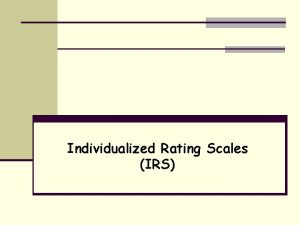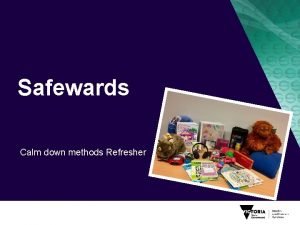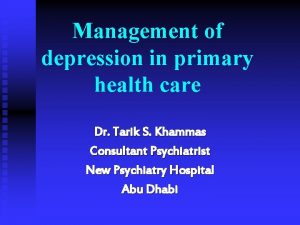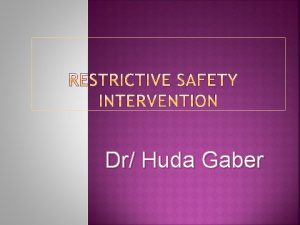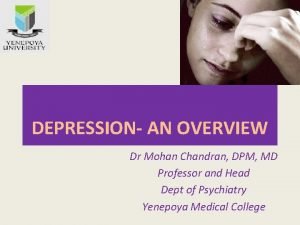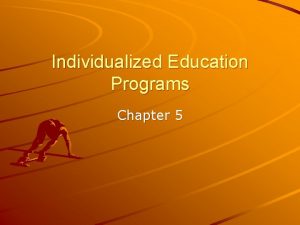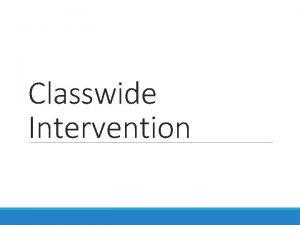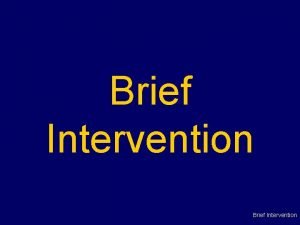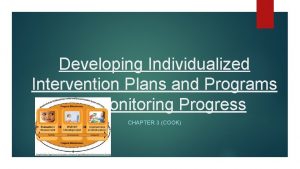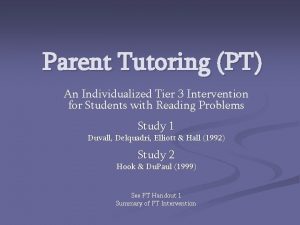Individualized Music Intervention to Reduce Agitation in Persons


















- Slides: 18

Individualized Music Intervention to Reduce Agitation in Persons with Dementia Linda A. Gerdner, Ph. D, RN Assistant Professor University of Minnesota School of Nursing

Agitation “An inappropriate verbal, vocal, or motor activity that is not explained by needs or confusion per se” (Cohen-Mansfield & Billig, 1986, p. 712)

Factors that Result in an Increases Risk for Agitation • • • Cognitive impairment Fatigue Misleading stimuli or inappropriate stimulus levels Affective response to perception of loss Internal or external demands that exceed functional capacity • Physical stressors (pain, discomfort, infection) (Algase, et al. , 1996; Cohen-Mansfield, Culpepper, & Werner, 1995, Deutch & Rovner, 1991; Hall& Buckwalter, 1987; Hall, Gerdner, Zwygart-Stauffacher, & Buckwalter, 1995; Ragneskog, Gerdner, Josefssom & Kihlgren, 1998)

Studies have shown that agitation may: • interferes with care delivery and social interaction (Legér et al. , 2002) • cause an increase in falls among residents in LTCF (Marx, Cohen-Mansfield, Werner, 1990) • interferes with onset and duration of sleep (Cohen. Mansfield & Marx, 1990) • a major source of stress to staff in LTCFs (Legér et al. , 2002; Ragneskog, Kihlgren, Karlsson, & Norberg, 1993)

Cognitive Impairment Lowered Stress Threshold Agitation Decreased Agitation Individualized Music Intervention Figure 1. Mid-range theory of individualized music intervention for agitation. From Gerdner, L. (1997). An individualized music intervention for agitation. Journal of the American Psychiatric Nurses Association, 3(6), 178.

Individualized Music that has been integrated into the individual’s life and is based on personal preferences (Gerdner, 1992).

Propositions of the Mid-Range Theory of IMAI • The temporal patterning of agitated behaviors in persons with ADRD is often predictable based on application of the PLST Model (Hall & Buckwalter, 1987). • Music evokes an individualized emotional response within the listener, that is associated with personal memories. • Response to personal memory is enhanced when music selection is based on the patients past personal preference. • The presentation of an individualized music intervention alleviates agitation in the person with ADRD. • There is a positive relationship between the degree of significance that music had in the person’s life prior to the onset of cognitive impairment and the effectiveness of the intervention. • Individualized music intervention is most effective when the intervention is implemented approximately 30 minutes prior to the peak level of agitation.

Evolution PILOT STUDY: Gerdner, L. A. , & Swanson, E. A. (1993). Effects of individualized music on elderly patients who are confused and agitated. Archives of Psychiatric Nursing, 7(5), 282 -291. MIDDLE RANGE THEORY: Gerdner, L. A. (1999). An individualized music intervention for agitation. Journal of the American Psychiatric Nurses Association, 3(6), 177 -184. THEORY TESTING: Gerdner, L. A. (2000). Effects of individualized vs. classical “relaxation” music on the frequency of agitation in elderly persons with Alzheimer’s disease and related disorders. International Psychogeriatrics, 12(1), 49 -65. EVIDENCE-BASED PROTOCOL: Gerdner, L. A. (2001). Evidence-based protocol: Individualized music intervention. In M. Titler (Series Ed. ) Series on Evidence-Based Practice for Older Adults. Iowa City, Iowa: The University of Iowa College of Nursing Gerontological Nursing Interventions Research Center, Research Dissemination Core. TRANSLATIONAL RESEARCH: Gerdner, L. A. (2005). Use of individualized music by trained staff and family: Translating research into practice. Journal of Gerontological Nursing, 31 (6), 22 -30.

Indications • Exhibit agitation as defined by Cohen-Mansfield (1986) • Score between 3 to 7 on the Global Deterioration Scale (Reisberg, Ferris, de. Leon, & Crook, 1982) • Hear a normal speaking voice at a distance of 1 1/2 feet • No obvious signs of pain or infection • Family member provide information on personal music preference.

Assessment of Agitation • Determine the time of onset and potential external or internal causes that may underlie these behaviors • If a physiological cause is suspected (i. e. , pain, infection) the physician should be contacted for appropriate medical attention.

Timing Optimal effectiveness is achieved by implementing prior to the patient’s “peak level of agitation” Monitor the patient over several days to determine any possible temporal patterning. For example, does the person usually begin showing signs of agitation during mid-afternoon. The prescribed time of intervention should precede this identified time by approx. 30 minutes.

P. R. N. • When patient first begins exhibiting signs of anxiety/agitation assess for possible internal and external stressors. • Eliminate potential stressors. • Play music when the patient first begins exhibiting signs of anxiety.

Assessment of Personal Music Preference (Gerdner, Hartsock, & Buckwalter, 2000) Designed to obtain details on the: • resident’s specific music preference • importance of music during independent living Completed by knowledgeable family member if degree cognitive impairment prevents the resident from providing this information

Examples of Individualized Music King of Western Swing: Bob Wills and his Texas Playboys The Best of Hank Williams Elvis Presley Amazing Grace: His Greatest Sacred Performances Mahalia Jackson Gospels, Spirituals, and Hymns The Very Best of Frank Sinatra

Intervention Protocol Check out audio cassette/CD player from nurses’ station Play music at prescribed time for approx. 30 minutes daily & p. r. n. Set volume to appropriate level Determine need and appropriateness for headphones

Assessment Assess need and appropriateness for headphones Conduct ongoing assessment of patient’s response to music. Monitor other patient’s in the immediate environment. Remember what is pleasing to one person may be irritating to another.

Adverse Response • It the agitation becomes more pronounced - stop the music. • Reassess music preference with patient or family member • Provide alternative music selection on the following day • If patient responses adversely to the second selection, discontinue the intervention.

Conclusion Individualized music intervention utilizes family expertise to promote humanistic, individualized care in an effort to enhance quality of life. Click your browser’s back button twice to return to EDGE
 One persons trash is another persons treasure
One persons trash is another persons treasure Online music portfolio
Online music portfolio Peter g schultz
Peter g schultz Individualized education plan
Individualized education plan Individualized healthcare
Individualized healthcare Individualized consideration
Individualized consideration Individualized rating scale
Individualized rating scale Example of idealized influence
Example of idealized influence Individualized family service plan example
Individualized family service plan example Differentiated instruction vs individualized instruction
Differentiated instruction vs individualized instruction Center for individualized medicine
Center for individualized medicine Signs of agitation
Signs of agitation Effexsor
Effexsor Project beta agitation
Project beta agitation What is psychomotor agitation
What is psychomotor agitation Land agitation
Land agitation Terminal restlessness
Terminal restlessness Objectives of size reduction
Objectives of size reduction Psychomotor agitation
Psychomotor agitation






